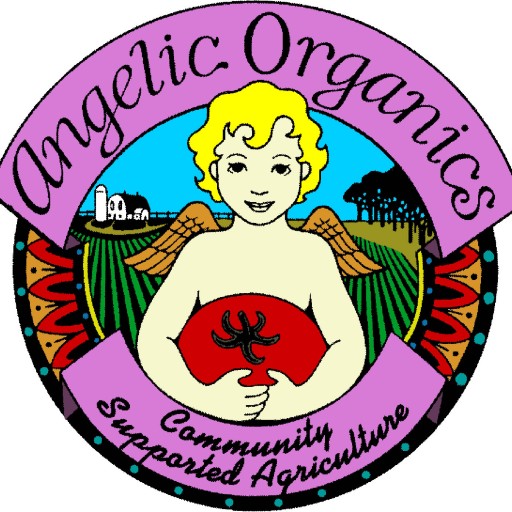Farmer John Writes: Important Update about Your First Delivery
Farm Report
Farming is full tilt these days. I suppose that’s why I haven’t provided you with a timely update of the season so far–I’ve been extremely busy in the fields.

Wagonloads of transplants keep us busy
Weather
This spring has been a bit different from the super wet springs of the last three years; this spring has provided numerous little windows between the rains in which we have been able to plant the crops in a timely way. I have been astounded by how much our crew has accomplished in those little weather opportunities in which we could till and plant. We have actually been able to do everything in the fields on schedule. When I reflect on the weather so far, I can not really understand how we could go so fast as to stay current, but current we have stayed. But, there was that cold spell.
Delay of Your First Delivery
The cold weather through mid-May has held many of the the crops back, so they are not ready for the week of June 8, when we were planning to start deliveries. We are current with our field work, but our crops aren’t current with our schedule for them. Apparently, the crops did not see our directives for their maturity schedule.

lettuce meets the earth
The First Week of the Season Will Now Begin June 22 (the Week of June 29th for Some)
We had an unusual hard frost in early May that was quite brutal on the kale and broccoli, causing their outer leaves to freeze and turn yellow. The tender inner leaves survived for the most part. Now these plants are recovering quite nicely, but they are a couple of weeks behind schedule. We were extremely fortunate that we did not have our frost sensitive crops such as summer squash, melons and cucumbers in the ground during that frost, or we would have lost them.
Our first delivery week of the season will now be the week of June 22. For some of our shareholders with half shares, the first delivery week will be the week of June 29. This means that your first delivery of the season will be two weeks later than your original confirmation email. The last delivery of the season will now be two weeks later as well.
Your delivery schedule was recently updated in the Harvie system. You can view your updated delivery schedule by logging in to Harvie at https://www.harvie.farm/member/profile. There, you can view your full calendar of deliveries for the season under the Deliveries tab.
If You Would Like to Add a Fruit Share, the Deadline for the Season is Sunday, June 7th
You can add a fruit share for this season by clicking “Place Order” on the main page of your Harvie profile here: https://www.harvie.farm/member/profile
Since you already have a vegetable share on file, you will skip ahead to Step 2 of the checkout process (“Select Add-ons”), and complete checkout from there. If you would like assistance adding a fruit share for this season, or if you receive home delivery and would also like to receive a fruit share, please contact email hidden; JavaScript is required.
Changing Your Delivery Location
If you would like to change your delivery location for the entire season, please email email hidden; JavaScript is required and we can make this update quickly for you. If you would like to add home delivery, please also contact us so that we can make sure you are properly registered for home delivery in the Harvie system.
Selective Sogginess
We are blessed to have enough fields to plant that are not waterlogged from the past several seasons of relentless rains. I am actually putting more fields into production than in any previous year, due to the huge demand for our shares. Still, about 1/3 of our fields are mud and impossible to plant in. We have water standing in fields that would normally be workable at this time of the year. Those fields are fallow in cover crops for future seasons.
To be clear, even though many of our fields are unworkable, we still have plenty of land in production for this year’s CSA—more than ever before.

once a well drained field
A Pertinent Reminiscence
Last year we buried our big tractor in one of those fields that have not dried up this year. Here’s a link to a Farm News story about that episode Monet Did it, Too, where you will find a sensational video on rescuing the tractor from the mud. (You might not find the video sensational, in this age of special cinematic effects and surround sound. But here on the farm, getting a tractor out of a deep mud hole is high drama.) About that mud hole where the tractor was buried, the mud hole is still there, full of water. As for burying a tractor in mud—when it’s really buried, like last spring, right up to the frame, I can’t help but imagine that it’s going to sink out of sight overnight. It’s just an image I can’t get out of my head. We go back the next day to pull it out—where is it? We’ve never lost a tractor that way, except in my imagination.

mud hole where the tractor didn’t sink out of sight last spring (Watch Triumph over Mud.)
Weeds
I could write a whole newsletter about weeds, or a chapter, even a book. For 20 years we were blessed to have a rotation system for our crops that kept reducing the weed pressure. I realize it’s a bit of a koan, but when I would be asked “why are your fields so free of weeds?” I would reply, “because we controlled the weeds in those fields last year.”
The last three years dealt us so much water, that we could barely get the crops planted or harvested. Our weed policy had to be subordinated to our mission to provide food for our shareholders. Besides the extra time that it took to harvest crops in rain and mud, the mud made it impossible to control the weeds with machines or hoes.
In April and early May this year, the weed presence in many of our fields was foreboding, the sort of weed pressure which will threaten that, without intervention, little or no crop will be harvested from those fields. Consequently, we have undertaken huge efforts to eliminate or at least subdue these weeds. We have various machines for mechanical control of weeds, which we have been relying on heavily. In addition, there have been days when we have had as many as 16 workers weeding the fields all day long (costing the farm well over $2000 per day). The mechanical weeding and the crew’s efforts have reduced the weed pressure dramatically.
I know some people will say “why not just co-exist with the weeds?” I suppose we could do that, if we weren’t endeavoring to provide bounty to our shareholders. It’s awkward to fill a box with excuses; excuses are hardly culinary.

crew of 10 weeding a beautiful stand of young carrots; some days, as many as 16 workers are weeding
The Virus Crisis has Caused a Resurgence of Interest in Community Supported Agriculture
Community Supported Agriculture is experiencing an enormous wave of popularity this year. We have done little marketing this spring and thankfully have sold out of shares. (Well, I might briefly open the door again to more share sales, as I see how the season is unfolding.)
Steps We Are Taking for Your Health and Safety this Year
Our food safety protocols for this season take into account recommendations by the Center for Disease Control to offer protection against COVID-19. These include:
- regular sanitizing of harvest and washing equipment
- making sure the crew adheres to Food Safety Modernization Act recommendations
- ensuring that our crew members are in good health
- advising our pack team to wear gloves and face masks while packing
- advising our delivery drivers to wear gloves and face masks
Safety Precautions for Those who Pick up at Community Sites
- We will stack your boxes in columns 2 to 3 boxes high, instead of the previous column heights of 4 or 5 boxes, to reduce the amount of handling, as long as we have adequate space at your site.
- We will stack your boxes only one row deep, for easier access to your respective box, if there is adequate space at your site.
- Please wear gloves and a face mask when you pick up at a community site.
- Touch other boxes as little as possible, when retrieving your box.
- Socially distance from other shareholders, if you are picking up your boxes at the same time
- If you are sick, please send a friend to pick up for you. Make sure that your friend has the pickup instructions. (Occasionally, a friend or spouse picks up at a site and comes home with the wrong box.)
- Consider signing up for home delivery, if you are not comfortable with picking up at a community site. Please contact email hidden; JavaScript is required to add home delivery. You can learn more about home delivery here and determine whether your zip code is eligible. The cost is $12 per delivery.
About the Box Itself
We are currently investigating whether to line your box with a food grade (ideally compostable) insert so that you do not bring your box home. Instead, you would retrieve your vegetables with ease via the insert. You would then leave your box at the site for us to pick up the following week. This added layer of protection would create a barrier between the inside of the (possibly re-cycled) vegetable box and its contents. It would also help to keep your box contents cool.
The liner would not be returned to the site. We would not be able to re-use the liner, but we do want to re-use the pricey boxes (about $2 each.) We realize this bag insert would require an extra step on the pack line, an extra expense for the farm, and an added packaging material for you to manage. We’ll update you as we further explore this possibility.
We’ll do our best to safely supply you with fabulous vegetables and herbs this season.
Thank you for being part of our farm.
Warmly,
Farmer John




Do fruit shares still start the same week as usual since they are not from your farm directly?
Hello – Since fruit shares are an add-on share, we don’t deliver fruit shares without a CSA vegetable share from our farm, and so fruit share delivery is also delayed. You can view your delivery calendar through Harvie here: https://www.harvie.farm/member/deliveries
Hello. I really like the idea of the box insert and would be willing to pay an additional charge to offset the cost to the farm. Thank you for all your efforts to keep things safe!! Can’t wait for this seasons bounty!
Thank you for letting us know, Leslie, and we appreciate your offer to help offset the cost of the liner. We probably won’t be adding to the price of the box this year due to the extra cost of the bag insert. It’s not a huge cost. Farmer John